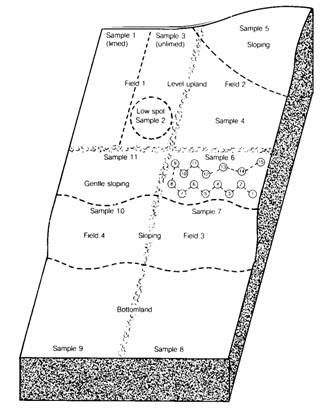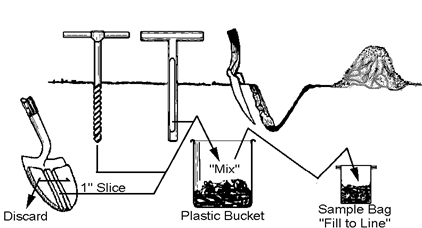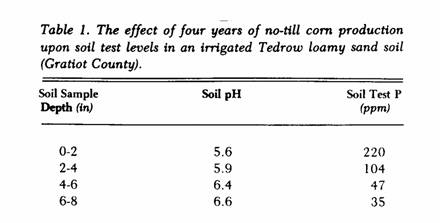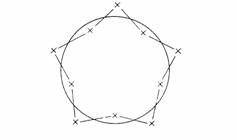A General Guide to Soil Sampling
The Benefits
Soil testing is the single most important guide to the profitable use of fertilizer and lime. It is in the best interest of farmers, lawn care professionals, landscapers, gardeners, fertilizer suppliers, and consultants to promote the use of soil testing for several reasons.
- Grow Higher Crop Yields
- Produce Higher Quality Crops And Ornamentals
- Use Fertilizer Dollars More Efficiently
The Goal
The purpose of soil testing is to identify the soil fertility that the plants or crop, in a given area will experience. The soil area and volume could be a large field, a small garden, or simply the root zone of a single tree or shrub. The most difficult step in soil testing is accurately representing the desired area of soil. A laboratory cannot improve the accuracy of a sample that does not represent the area.
In most soils, it takes more than one year to make significant changes to the soil test levels. As the soil improves with better fertility programs, subsequent crops or plant growth should show increasing rates of improvement. Soils are formed over thousands of years, and are not easily changed in a short time.
The Method
You should plan how the field is to be sampled before you begin. You should plan how you will divide the field into sampling areas…then always use the same areas in the future. A soil map, available at the county Soil Conservation Service office will often be helpful. Some factors that might cause you to sub-divide the field into separate sampling areas are…
- The size of the field
- Different soil types
- Different topography
- Different past usage (previous crops, livestock confinement, fertility practices, etc.).
- Fertilizer application capabilities
- Different past crop performance
Soil test levels in any soil area will vary both laterally and vertically. This, plus the intended use of the field, dictates how the field or area of land should be sampled (see example in Fig. 1).
A Few Universal Basics
- Soil samples can be taken with a professional soil probe, or simply using a shovel, spade, or garden trowel (see fig. 2).
- Each sample should be composed of from 10 to 15 cores.
- The cores should be taken in a random pattern that is uniform across the area being sampled (grid sampling may require a specific pattern).
- Each sample should represent 10 acres, or less, per sample (grid samples will represent from 2.5 to 5 acres per sample).
- Normally for most agronomic crops and conditions, each sample core should be taken to a depth of 7 inches in tilled fields. Special conditions such as no-till, orchards, turf, and others are discussed in the following sections.
Tip: Permanently mark your soil probe at the depths that you expect to pull samples. This will help you maintain constant depth. A probe with a welded foot pedal at the correct depth is also helpful.
- Complete the information on the soil bag while you are in the field! Assign each sample bag an ID consisting of up to 12 letters and/or numbers that will let you identify it later. Record the sample ID on a field map (hand drawn if necessary), as well as the pattern and locations in the field that the samples were taken. This will enable you, or others to take the next samples in the same locations.
- Enter all necessary information on the soil sample information form, and check to see that it agrees with the soil bags it accompanies. These forms can be obtained on our web-site at www.spectrumanalytic.com
The Tools:
- Soil sample bags, soil information forms, and shipping boxes obtained from Spectrum Analytic, Inc.
- A chrome plated or stainless steel soil probe or auger. Shovels and spades may be used (see Fig. 2), but they are inefficient.
- A plastic bucket to mix the “cores” of soil in. Do not use equipment made of galvanized metal. The soil sample will be contaminated by the zinc in the galvanized metal.
- A pen or marker with water-proof ink for labeling the soil bags.
- We recommend that you take a clipboard or notebook and, if possible, field maps to record how the field was sampled.
- If you plan to be sampling large acreage's each year, you may want to invest in larger equipment to improve efficiency such as ATV's, hydraulic soil samplers, etc.
Sending Samples to the Lab:
Pack the soil sample bags into the boxes available from our lab, or other suitable shipping containers. If you have less than a full box of sample containers, it would be best to include some additional packing to keep the soil sample containers from sliding loose in the box. Be sure to include a completed Soil Sample Information form in the boxes. If you do not use our soil sample information form, be sure to list your full name, address, and telephone. Also, include a list of samples in each box with your sample number included. Finally, tell us which tests we are to conduct, and whether or not you want fertilizer recommendations. If you want fertilizer recommendations, you must tell us the crop and yield goal, or plant species if ornamentals are being grown. While our soil sample bags are extremely water resistant, and we can accurately analyze “mud”, it will be difficult for you to pull representative samples from a muddy field.
Tip: We strongly recommend that you send samples by UPS, or a similarly efficient method. Most of our customers use UPS, and we often get 2 day service from anywhere in the country. Third class mail can take many days, and may cost more for heavier boxes.
Tip: When you have several boxes to send, put a shipping label on each box, then tape several boxes together…you'll get a cheaper shipping rate from most carriers! Check with your carrier for any weight limits that may apply.
Sample Turnaround Time:
We will typically complete a soil analysis on the following work day after we receive the sample. We often work on Saturdays and sometimes Sundays during the peak of the busy fall season. The printed report forms will be returned by first-class mail. Total sample turn-around time will typically range from 6 to 10 days, depending on how you ship samples to the lab. Sample results can also be accessed at www.spectrumanalytic.com, or by e-mail. Contact Spectrum Analytic to set up this service.
Special Sampling Situations:
1. No-till
Research indicates that it is advisable to take 2 separate soil samples. A 2 inch deep sample to evaluate surface pH, and a normal 7 inch deep sample for nutrient information. Since most fertilizer N is applied to the surface of no-till soils, they tend to develop a much more acid layer in the top 2 inches (see Table 1). This can lead to poor performance of herbicides. No-till practices cause significant nutrient stratification in the soil, which can complicate sampling and interpretation. However, fertilizer recommendations are still best accomplished with a normal 7 inch deep sample.
2. Fields with Banded/Starter Fertilizer
As you read this, you may decide that neither option is practical. If so, the best approach is to either avoid any known fertilizer bands entirely, or to take at least 15 cores per sample, pulled at random across the area to be sampled. This approach is not perfect, so you may see some unusual results at times. If you want to use a more “scientific” method, read on. These methods are applicable to both “starter fertilizer” bands, and those from pre-plant “field banding”.
The key to getting statistically correct representative samples is to take the correct number of cores of soil from outside a band, in relation to each core taken in the band. The following systems are the best methods that we know to determine the ratio of “in-band” to “out-of band” soil cores.
- Known Band Location: In this case, use the following formula to determine how many cores to take, and how many of them should be outside of the band.
- S = 8 x [band spacing (inches)/12] (Where S equals the number of cores taken outside of the band for each core taken in the band.)
- Unknown Band Location: In this case, some version of random sampling is the only choice. Research has shown that the statistically best method is as follows. Take the first core in a sampling area at random. Each subsequent core should be pulled at one-half the band spacing away from the first, while walking at a 90 degree angle to the direction that the bands were applied. Again, pull 15 cores for each sample bag, as described above, for maximum accuracy.
3. Soil Nitrogen Sampling
Since nitrate-N (NO3-N) is the dominate form of N in most soils, most calibration data and interpretation is based on it (even though the crop can use both forms of N). This work assumes a typical background level of ammonium N (NH4-N). This presents several conditions that must be taken into account to get the best use out of soil N testing.
- NO3-N is mobile in the soil, so a deep sample must be taken. In the humid parts of the country (most of the country) the research is calibrated to a 1 ft deep sample. In the dry Great Plains it is calibrated to a 2 ft deep sample. At the time of this writing, there is no calibration for a sample taken at a more shallow depth.
- The assumed background level of NH4-N can be dramatically wrong if the grower is using a nitrification inhibitor, or slow release form of N. In these cases, you should request that both forms of N be tested for. In any event a significant amount of NH4-N can convert to NO3-N while the soil is in the bag causing your results to be higher than the crop will experience in the field. This will lead to a lower than needed recommendation for additional N. We recommend that each soil N sample be either be shipped “next-day” delivery, or force-dried before shipping it to the lab. The actual temperature that is needed is about 100 to 110 degrees F, but microwaving the sample on the high setting until dry may be the easiest method. Microwaving will over-heat the sample, thus causing it to be unsuitable for other tests, but this is OK because the other tests aren't appropriate for a 12” to 24” sample anyway.
4. Tree Crops - Orchards, Christmas Trees, Nurseries
Tree crops must be sampled much differently than row crops or forages. Also, with tree crops, plant analysis is more important that soil testing, and should be done every year! There are several opinions on the best way to sample tree crops, and they are somewhat dependent on the planting pattern of the trees. We prefer the following; however it requires additional care on your part…
- Organization - Divide the field into blocks of trees of the same species, the same general age, and the same general soil conditions (topography, color, etc.). Within each block, select 5 trees that are typical of the general condition of that block (size, health, yield, etc.). These trees will be used as indicator trees for the rest of the block. They will be intensively sampled (soil and foliage) and monitored as a guide to the treatment of the entire block. These indicator trees should be permanently marked or tagged so that you can come back to them each year for re-sampling.
- Soil Sampling - From each indicator tree in a block, pull 3 to 4 cores from the drip-line of the tree (the outside perimeter of the maximum foliage diameter). The resulting 15 to 20 cores will make up a single soil sample. Mix the cores well and take about a cup of this soil for the sample and send that to the lab. Fertilize the entire block according to this sample.
- Plant Sampling - With tree crops of any type, it is important to use annual plant analysis in addition to periodic soil samples to determine your fertility programs. This is due to several reasons, such as a trees' extensive root system, nutrient storage by some woody plants, and slow internal nutrient transport by large trees. It sometimes requires more than one year for woody perennial plants to give the maximum response to a change in fertilizer programs. Take this year's leaves/needle along with a less frequent soil sample to develop and refine the fertility program for the next season. You can also use leaf/needle analysis to determine the need for foliar sprays. The proper tissue to sample is… Fruit trees: youngest fully matured leaves on current years twig growth, 30+ leaves…Conifers: the entire current years growing tip after it has hardened, 20 to 30 tips
5. Lawns and Turf
Sample depth should be 4 inches, and should not include accumulated surface organic materials such as thatch, or the blades of grass. It would be desirable to not include the grass roots either, but this may be nearly impossible to avoid. Sample handling procedures at Spectrum Analytic will remove most of the roots and larger pieces of non-soil material. The pattern of taking the cores is similar to that used in sampling crop fields (random and scattered), and avoiding unusual areas, unless the unusual areas are of interest.
6. Nematode Sampling
We offer analysis for soybean cyst nematodes. The following instructions apply to all nematode samples. However, soybean cyst samples do not require that the nematodes be kept alive in the sample during transit to the lab. If you sample a field for nematodes other than soybean cyst nematodes, you will need to take special steps to insure that the soil moisture and temperature are correct at all times for the nematodes survival.
Nematodes do not normally infest a field in a uniform pattern. You will normally see an oval to irregular pattern of stunted plants (possibly dead ones in the center of the damaged area). It is best to take a nematode sample in the growing crop, so you are sure to sample the infected area of the field. In a growing crop, take from 10 to 20 cores from the perimeter of the affected area (see Fig. 4) to make a sample. You should avoid the interior of a dead area because the nematodes will have either left the area, or died due to lack of a host plant. You want to sample the area of heavily infected plants, so you will also want to take the cores from within the root zone, where the nematodes are. The depth of sampling should be from 6 to 8 inches in all soil except sandy soil, where your cores should be 10 to 12 inches deep.
Make a 1-2 pint composite sample from the cores, place it in a regular soil sample bag and ship it to the lab. We do not have a special nematode information form at this time, so simply write on the regular form that a particular sample is to be tested for soybean cyst nematodes.
7. Subsoil Samples
As a general rule, you gain most of the needed soil fertility information from proper topsoil samples; however there are times when a sub-soil sample can provide valuable information. Roots must thrive in the entire natural rooting volume of the soil for top yields. Most cultivated plants, except some turf varieties and a few ornamentals, extend their root systems into the subsoil, so problems in the sub-soil can limit yields. This is especially true of deep rooted perennials, annuals with tap roots, and trees. The subsoil can inhibit root growth in several ways such as undesirable pH, deficient or toxic levels of certain elements, severe compaction, excess moisture, and possibly other reasons. In these cases, the roots will be restricted to the topsoil for their entire needs. This can lead to nutrient or water stress and lower yields. Of course, correcting sub-soil problems can be very difficult, so identifying the cause of a problem does not necessarily mean that there is a practical solution.
Subsoil samples should be taken separately from the topsoil sample. To do this, first take the appropriate topsoil sample and place it into a plastic bucket. Then insert the soil probe back into the same hole and take another core to the new depth. Place these cores into another plastic bucket. When you label the bags of soil, and the soil information forms, record the depth of each sample for future reference. The lab analysis will be the same for each of the two samples, and we do not have a special recommendation program for subsoil samples, but the subsoil results can be used to modify the recommendations from the topsoil sample on a case-by-case basis.
Common Questions About Soil Sampling:
Q: When is the best time to take soil samples?
A: Anytime that you need them! In the fall, just after harvest is usually the preferred time in farming because the fields are empty and sampling is quicker, and the crop has had all season to pull nutrients out of the soil. A key to proper soil sampling is to be consistent. It is important to try to always sample a given field at the same time of the year. A field may give different values in the spring vs. the fall.
Q: How frequently should I resample a field?
A: It depends…Every two or three years is OK for most fields. Sandy soils that have very low nutrient reserves or fields producing high value crops such as fruits and vegetables could be sampled every year. Also, sample every year when there is an aggressive soil build-up program, or when there is a significantly low fertilizer rate.
Q: Should I sample an area even if it can not be fertilized separately?
A: Maybe…It may be worth sampling a “poor growth” area in order to find out why it performs as it does. You may get a clue as to how to “fix” a poor area.
Q: Are there areas of a field that should not be sampled?
A: Yes. Avoid the following areas in the field, especially when they cannot be treated separately (see section on grid sampling).
- Old fertilizer bands, if possible (see section on sampling banded fields)
- Areas or fields that have had lime or fertilizer applied within about 30 days.
- Dead Furrows and end rows
- Stay 50 feet away from barns, roads, and fence rows, unless you intend to sample them separately for special purposes.
- Avoid areas where livestock congregate, or did in the past.
- Small, very poorly drained spots in the field
Q: Can I sample frozen soil?
A: Yes…While it is true that a frozen sample will probably show slightly higher levels (no more than 10%) of cations (K, Mg, Ca, etc.), the difference in recommendations will be small.
Final Point
We are here to help you. Please call us anytime that you have questions about any aspect of soil sampling, understanding the results, or any area of agronomics.



